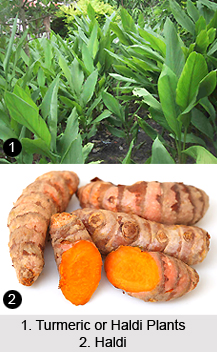 The Haldi or Turmeric tree bearing the scientific name Zingiberaceae Curcuma longa has many other common names attached to it. In Bengali it is known as haldi while in English it is called turmeric. In Gujarati it is called halada and in Hindi it is known as haldi or hardi. In other languages such as Kannada it is known as arishina, in Malayalam niannal or marinalu; in Marathi halde or halede; in Punjabi haldar or halja and in Sanskrit haridra. The tree is found in Punjab, West Bengal, Maharashtra, Karnataka, Tamil Nadu and Kerala. The plant is believed to be indigenous to Bihar.
The Haldi or Turmeric tree bearing the scientific name Zingiberaceae Curcuma longa has many other common names attached to it. In Bengali it is known as haldi while in English it is called turmeric. In Gujarati it is called halada and in Hindi it is known as haldi or hardi. In other languages such as Kannada it is known as arishina, in Malayalam niannal or marinalu; in Marathi halde or halede; in Punjabi haldar or halja and in Sanskrit haridra. The tree is found in Punjab, West Bengal, Maharashtra, Karnataka, Tamil Nadu and Kerala. The plant is believed to be indigenous to Bihar.
Turmeric is a tall herb with cylindrical tubers that are bright yellow or orange inside. The leaves of the tree are very large. Its tufts grow upto 1.2 m long including petioles. Each petiole grows as along as a leaf blade. The flowers of the tree are usually pale yellow, borne in spikes 10-15 cm long. The tree is cultivated in the tropics throughout India up to 1500 m altitude.
Medicinal Properties of Haldi
The turmeric powder is obtained from the dried, powdered rhizome. This turmeric power is widely used in cooking Indian food. Turmeric has strong antiseptic properties which are used for treatment of poisonous affections, ulcers and wounds. In Ayurveda, is considered to be alterative, antiperiodic, germicidal, carminative, stimulant, tonic and vermifuge. It is used to treat diabetes, eye diseases, ulcers, oedema, anaemia, anorexia, leprosy and many other diseases. The turmeric paste when combined with that of neem leaves (Azadtiachta indica: Meliaceae) is used in curing ringworm, itching, eczema and other parasitic skin diseases. It is also used in the treatment of chickenpox and smallpox. If applied externally it gives relieves to sprains and bruises, and to improve skin complexion and resolve pimples. It is also internally essential for treatment of blood disorders. The fresh juice obtained from the rhizome is very useful. The decoction of the rhizomes when applied externally provides relief to cold and conjunctivitis. Even the paste of the flowers is helpful in treating ringworm and other parasitic skin diseases and gonorrhoea.











